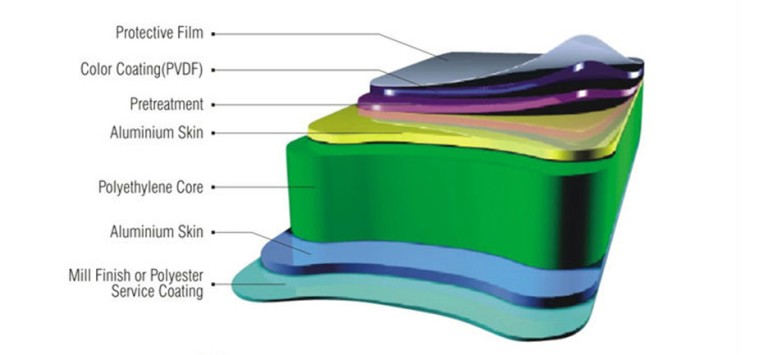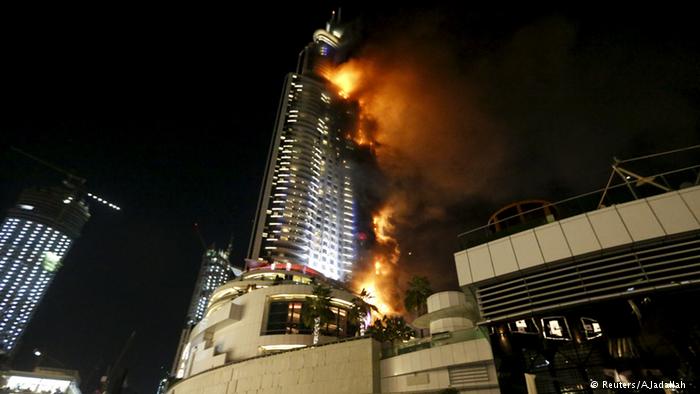On the 31st December 2015, the Address Down town Hotel, Dubai was set ablaze by an electrical fault. The fire spread unprecedentedly quickly up the building’s exterior. There was a single fatality; however this is Dubai’s third major skyscraper fire since 2012.
Worryingly up to 70% of skyscrapers built before 2012 contain these panels responsible for 3 fires since 2013.
Considering past events, is modification of compromised structures a necessary investment in the interest of public safety?

For renovation of other compromised buildings
Fire damage is expensive, ugly and damaging to surrounding businesses. Preventative renovation would be a long term investment, ensuring public safety and upholding Dubai’s image. Since 2013 there has been 1 major fire each year accredited to the flammability of exterior cladding confirmed Jun Xu’s study [1]. It is only a matter of time until this cost surpasses the cost of correcting this dangerous design error. Then we have to consider both past and potential loss of life due to fires. In the hotel fire on New Year’s Eve there was 1 death and 14 injuries [2], as the fire was almost entirely external. Imagine if the fire started internally, engulfing 2 lower floors, and then spreading up the external walls in a similar fashion, how would this impact the death toll? Ethically, the loss of even a single life should justify rectification.
We must also consider potential the loss of business as public awareness of the danger increases. It is predicted that 70% of skyscrapers in Dubai built before the Aluminium-polyurethane composite panels (ACP) in 2012 are at risk. Would you take your children to Dubai knowing that unattended barbecue on the balcony could set the entire building ablaze in 30 minutes?
Before any changes are made, the party at fault must found. As it is today, no involved group will institute change until they are sure it is there mistake to rectify. The use ACP was standard practise until 2012; hence initially the building engineers are look unlikely to be at fault.
 Alumco the company that won the bid to supply 35,000m2 of panelling for the Address Down town Hotel in a $20,000,000+ deal. Chief executive of Alumco Samer Barakat stated during an interview with ‘The National’ [3]; “two-thirds of Dubai buildings use non-fire rated ACP panels”, confirming the company’s knowledge of the issue. However he then states “We complied. We gave all submissions; there was approval on every submission according to specification”. This points the blame back towards the buildings architects and engineers, for approving the use of non-fire rated materials. However this could be due to financial pressure or bribery to keep within budget, I am interested to see what the official investigation suggests, and who it implicates with later this year.
Alumco the company that won the bid to supply 35,000m2 of panelling for the Address Down town Hotel in a $20,000,000+ deal. Chief executive of Alumco Samer Barakat stated during an interview with ‘The National’ [3]; “two-thirds of Dubai buildings use non-fire rated ACP panels”, confirming the company’s knowledge of the issue. However he then states “We complied. We gave all submissions; there was approval on every submission according to specification”. This points the blame back towards the buildings architects and engineers, for approving the use of non-fire rated materials. However this could be due to financial pressure or bribery to keep within budget, I am interested to see what the official investigation suggests, and who it implicates with later this year.
Renovation itself is a major aesthetic issue when considering Dubai’s natural beauty, irrespectively the short term effects of extensive scaffolding seem insignificant if you think about the potential 10 buildings damaged by major fires we could see in 10 years’ time if currents trends continue.
A final point to consider is regarding informed decisions: Should the government/building owners be required to forewarn the general public of other buildings made using un-rated ACP’s, so they can make an educated decision before putting themselves at risk?
Against renovation of other compromised buildings
The number of casualties from this incident and even the previous two building fires in Dubai cannot justify the millions that would be spent on renovating all exterior claddings on every skyscraper in the city.
In the latest fire incident there was only 1 fatality, and 14 injuries, this outcome cannot justify spending millions on renovations. It would be best to spend that money on the firefighting services; i.e. obtaining more advanced and efficient ways in combating these potential fires, or the installation of a water sprinkling system on the exterior of the building that would help combat any potential fire. These two solutions would significantly more cost effective than renovation of exterior claddings throughout Dubai’s high rise buildings. Moreover, loss of revenue due to business closure from renovation would greatly exceed the expense due to a potential fire.
All skyscrapers in the city were allowed [4] to have exterior cladding made from ACP before 2013 when it was banned. Most high-rise buildings in Dubai use ACP exterior panelling as it is durable, rigid, and easy to bend, fold, cut, punch, drill, route, glue and screw. It is a perfect choice of construction material considering the aesthetic appeal, and convenience of construct; can this outweigh the potential fire risk? It is hard to say that the engineers should take responsibility and blame for this incident or any potential fires that can arise due to this. Before the ban to use ACP for exterior claddings on skyscrapers in city buildings these issues were no-existent. Most of the skyscrapers are in excess of 5 to 10 years old, yet only recently have building fires started due to minor accidents such as cigarettes buds or electrical faults. It is a reasonable assumption that improper maintenance by buildings staff/management significant factor here.
The decision of using ACP is closely associated with exterior design and aesthetic outlook. It is hard to find replacement material which can fit the buildings in both aspects of aesthetics and quality. Dubai is well-known for its attractive and well-designed buildings as well as hotels and resorts, so if we start re-constructing and renovating all high buildings this could affect the beauty of the city that draws in many visitors. Taking into account that changing the claddings on every high rise building would take a considerable amount of time making the city look less attractive as well as potential loss of the business and revenue that tourism brings to the city.
Finally, should the government invest significant funds into changing all exterior claddings on skyscrapers to reduce potential fire risk, but at the cost of admitting their mistakes; which could result in loss of tourism business, or should they find cheaper more effective ways to combat potential fires?
Until the official investigation report has been released, it is difficult to place the ‘blame’ on a single party. Who do you think is at fault? Should any precautions be taken?
10: Oscar Swindley, Jun Liu, Michael Osoba, Yu Lei
Renovation of the building structure would cost significantly much more, and it won’t eliminate the fire risk. On the other hand, investigating in fire extinguisher and other anti fire equipment would be much cheaper and more effective.
LikeLike
it raises the question though, how do we put public safty as a priority and as a incestive to continualy invest in public safty. especialy in a place where bribary is common we must make it so that there is a direct incentive in these developments.
LikeLike
Architects and officials who give planning permission are at fault. A company cannot be held accountable for building materials to specification.
Now the issue is known however, replacing the materials is not cost efficient and will result in a significant loss of industry/tourism. I think money should be pledged to better fire safety protocalls, better fire response services and cheaper fire deterants (ie sprinklers). Perhaps a body or council should be put in place to enforce new saftey measures.
LikeLike
When thinking about implementing the potential renovation programme, we should also think about the injury rate on construction sites in such places. Statistically, how many fatalities and injuries would result from the programme of retrofit? And is the safety of the immigrant workforce on-site considered to be less important than the safety of the rich folk using the high-rise hotels? A final question, which would save more lives/ injuries/illness: millions spent on retro-fit or an equivalent investment in site safety and zero-harm building sites across the UAE? I don’t know the answer, but would want to in order to make an informed judgement.
LikeLiked by 1 person
Few funds should be invested to change the cladding material as it is not the main cause. Instead, minor accidents and excessive age of building reveal the defects of management and hazards of facilities and these shortcomings directly lead to the fire. Remedy these bugs and spend money on the firefighter services would spend less money but more effective than changing cladding.
LikeLike
Matetial of cladding is not the main reason of fire. Instead, minor incidents and excessive age of building reveal the defects of management. I think spending money on changing material would not improve safety issue. Invest money on improving fire fighter services and relevant facilities would take less but provide more effective way to reduce the risk
LikeLike
Whether to change the material or not, it depends.For the governments,they may not willing to change,it’s a huge investment,while for the public,safety is their most concerns.so in my opinion,the compromised way may be,they should strengthen the surveillance of buildings and supply more extinguishers, and the buildings built in the future must adopt the new material.
LikeLike
Fires happen, although preventing them would be best, the problem in this scenario is how quickly the fire spreads. So far the fires have started high enough up the building that residents have been able to use the exits but the next one might not be so fortunate. If the lower floors get engulfed in flames before people can get out then the chance of saving them will be low. What they need is time to escape, this can only be achieved by slowing down the spread of the fire. Sprinkler systems would help but it’s fighting from the disadvantage of particularly flammable building materials. Changing this would bring it back to a level playing field and give firefighters a better chance to save people.
Public knowledge of this problem is growing so much worldwide from the latest fire, people already know the materials used are why the fires are so dramatic. There’s no longer any point in trying to cover up that allowing these materials to be used on such tall buildings was a mistake. Tourists want to see that everything possible is being done to combat the problem, rather than cutting corners yet again.
LikeLike
Interesting read! I agree with Shuai. I think calling for a renovation would only apply in extreme measures because alternative and cheaper fire preventative measures can be undertaken.
LikeLike
Rather than only renovation of other compromised buildings, it would be better to find a efficient way to provent fire. After find an good method to prevent or reduce the fire breaking out, then goverment should consider is that necessary to renovate the compromised buildings. I am greatly convinced that prevention is better than cure.
LikeLike